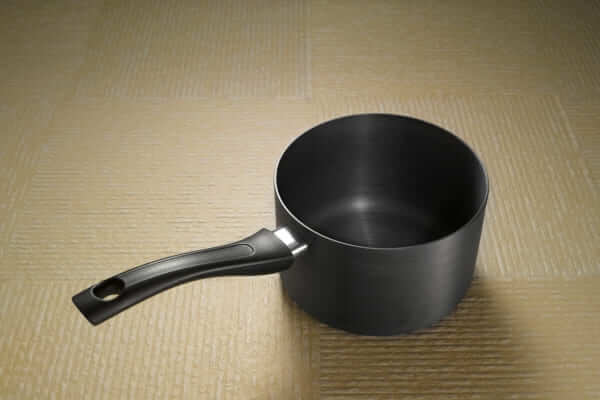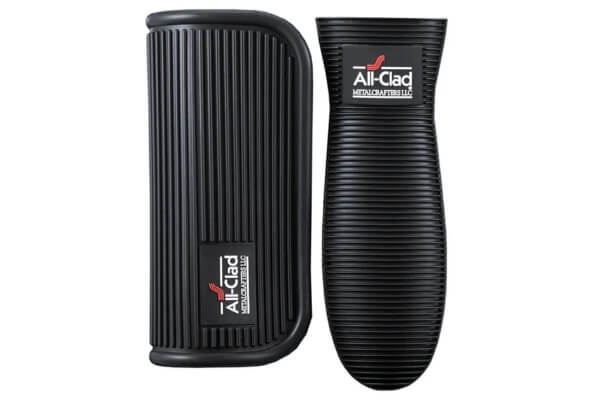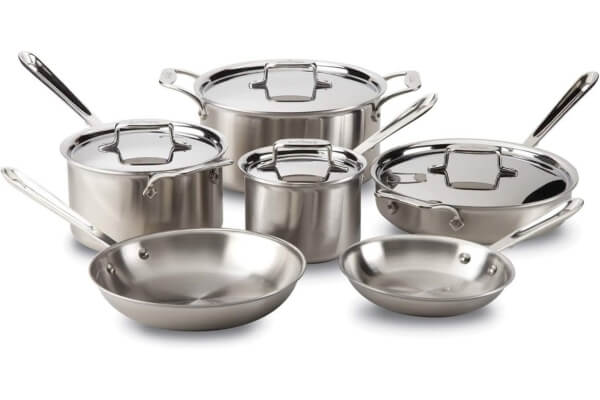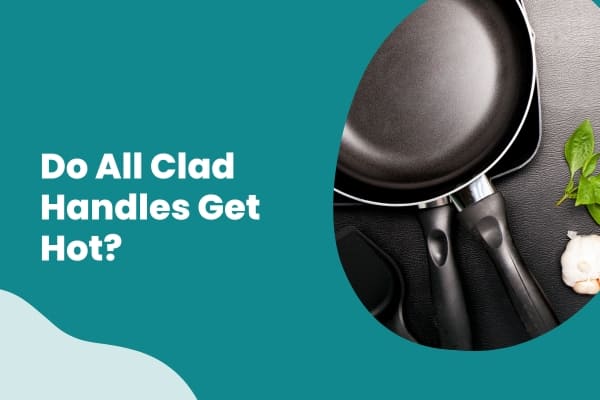As a cooking enthusiast, I’m always looking for high-quality cookware. And All-Clad is one brand that never disappoints! But one question often pops up – do All-Clad handles get hot?
Well, that’s a valid concern, right? I mean, who wants to burn their hands while whipping up a culinary masterpiece? That’s why I’ve decided to delve into this topic.
This article explores how hot All-Clad handles can get, discuss the heat conductivity and distribution across the cookware’s surface, and share some tips to prevent burning your hands. We’ll also look at factors affecting handle temperature and provide useful tips for safely using All-Clad cookware handles.
Plus, we’ll delve into whether All-Clad handles are comfortable to use. So, let’s start and ensure your cooking experience is safe and enjoyable!
Do All Clad Handles Get Hot?

As someone who often uses All-Clad cookware, I’ve noticed a few things about their handles.
When cooking on the stovetop, the handles can get hot, particularly if you’re using high heat or cooking for an extended period.
But if you’re wondering about the oven or broiler, it’s important to note that the handles are designed to withstand high temperatures, but they can still get hot, so it’s always a good idea to use oven mitts or a pot holder.
On the stovetop
You’ll feel the heat if you grab an All-Clad handle on the stovetop, so it’s best to use an oven mitt! The handle durability is designed with high-quality materials to withstand high temperatures, but they get hot.
It’s all about the heat setting and the size of the pan. For instance, a small saucepan on high heat will cause the handle to get hotter than a large stockpot on low heat.
Remember, the freedom to cook safely and effectively comes with understanding your cookware. Knowing how your All-Clad handles react to heat allows you to create culinary masterpieces without the fear of getting burnt.
So grab that oven mitt and whip up your best dishes with confidence!
In the oven or broiler
When you’re roasting or broiling in the oven, it’s essential to remember that pot and pan grips can become scorching, so always keep those oven mitts handy for safe handling. All-Clad handles are no exception – the oven heat can cause them to become extremely hot, much hotter than they would on the stovetop.
In terms of oven safety, here’s a quick table to demonstrate the importance of using protective gear:
| Situation | Solution |
|---|---|
| All Clad handle is hot | Use an oven mitt |
| Forgot to use an oven mitt | Apply cold water to burn immediately |
Always remember using All-Clad or any cookware in the oven requires proper safety precautions to avoid burns and injuries.
How Hot Do All Clad Handles Get?

Sure, All-Clad handles can heat up, but they’re not about to scorch your hands off on the stovetop. Their unique design allows for handle insulation, meaning they don’t conduct heat as much as other materials. Depending on your cooking style and heat setting, the handles can become slightly uncomfortable to touch, but they won’t burn you outright.
Remember, the pan size can also impact how hot the handle gets.
A small saucepan on high heat will be hotter than a large stockpot simmering on low. However, when it comes to oven use, these handles can get hot enough to burn, so always make sure to use oven mitts for safety.
Heat Conductivity and Distribution Across the Surface of All-Clad Cookware
As someone who spends much time in the kitchen, I appreciate All-Clad cookware’s superior heat conductivity and distribution. The secret lies in using high-quality materials like stainless steel and aluminum. These materials not only provide durability but also ensure even heat distribution across the surface of the cookware.
Whether searing a steak or simmering a sauce, with All-Clad, you can count on consistent cooking results every time.
What Materials Are Used in All-Clad Cookware, and How Does It Affect Heat Conductivity?
You’ll be amazed that All-Clad cookware ingeniously combines stainless steel, aluminum, and sometimes copper, creating an impressive balance of durability and heat conductivity that’ll take your cooking to the next level. These materials bring unique qualities to your cookware, contributing to their ‘Material Durability’ and heat distribution.
Here’s a neat breakdown of these materials:
| Material | Durability | Heat Conductivity |
|---|---|---|
| Stainless Steel | High | Moderate |
| Aluminum | Moderate | High |
| Copper | Low | Very High |
Stainless steel offers strength and resistance to corrosion, while aluminum and copper ensure excellent heat conduction. However, All-Clad often includes a layer of stainless steel over the copper core to prevent reactivity with acidic foods. This clever design ensures even heat distribution without compromising on durability.
How Is Heat Distributed Across the Surface of All-Clad Cookware?
Imagine cooking with a pan that distributes heat evenly across its surface, ensuring that every ingredient in your dish is perfectly cooked. That’s exactly the kind of experience you get when using All-Clad cookware.
The stainless steel exterior prevents heat escaping, creating a consistent cooking environment. The aluminum core, known for its excellent heat conduction, helps distribute heat throughout the pan. The copper core, an even better heat conductor, is ingeniously sandwiched between layers of stainless steel to prevent reaction with acidic foods. Combining these materials and construction methods ensures perfectly cooked food every time.
Cookware maintenance is crucial to preserve these features. Clean regularly and avoid extreme temperature changes to maintain heat distribution efficiency. Enjoy the freedom of cooking with All-Clad, where every meal is a culinary masterpiece.
How to Prevent Burning Your Hands on All-Clad Handles
Sure, All-Clad handles can get hot, but don’t worry, there’s no need to singe your fingers if you follow these handy tips.
First off, make use of potholders or oven mitts. They’re your trusty shields against the heat and are easy to find.
Avoid touching the handles directly, even if they’re not scorching hot. Handle materials are designed for high heat capacity, meaning they can absorb much heat before turning hot. But don’t be fooled; they can still be uncomfortable to the touch.
If you must handle your All-Clad pans without protection, just give them time to cool down.
And remember, always preheat your oven or broiler before popping in your pan. It’s all about being aware and taking the right precautions!
Factors Affecting Handle Temperature
Understanding the variables that influence the warmth of a cookware handle can significantly enhance your cooking experience and safety in the kitchen. The handle’s material, size, and thickness all play crucial roles in how much heat it absorbs. All-Clad handles, for instance, are typically larger and thicker, providing better insulation and less heat transference.
Handle ergonomics also plays a part in this. A well-designed handle can help dissipate heat more efficiently, keeping it cooler to the touch. Additionally, the type of stovetop you use and how long the cookware is heated also impact handle temperature.
Remember, freedom in your kitchen means understanding these factors and choosing cookware that best suits your needs and ensures your safety.
Tips for Safe Use of All-Clad Cookware Handles

Remember, using oven mitts or potholders is essential while handling your All-Clad cookware. This is the best way to prevent any unwanted burns. The handles are made with durability in mind, but they can still get hot.
Here are a few tips for safely using All-Clad handles:
- Before touching, let the cookware cool down. Handle durability doesn’t mean they don’t get hot.
- Preheat your oven or broiler before inserting the cookware. This reduces the chance of the handles getting too hot.
- Be aware of the high heat capacity of the handles. They can absorb a lot of heat before getting hot, so always be cautious.
Following these tips ensures a safer cooking experience while enjoying the freedom to create delicious meals.
Are All Clad Handles Comfortable?
So, you’re wondering if these stainless steel grips are comfortable? As someone who uses All-Clad frequently, I can tell you it’s quite subjective.
Some folks, like myself, find the handles to be quite comfortable. They’re sturdy, well-designed, and provide a good grip. Despite being made of cast stainless steel, they maintain a bearable temperature, even after long cooking sessions.
However, not everyone shares this opinion. Some find the handles too thick and heavy, making it a challenge to maintain a steady grip, especially for those with smaller hands. And yes, the handles can get hot if the cookware is heated for a long time. It’s really about what feels right for you
Conclusion
So, in my experience, All-Clad handles can get hot, especially if you’re using high heat or cooking for a long time. It’s all down to the cookware’s impressive heat conductivity.
But don’t worry; there are ways to prevent burns, like using handle covers or oven mitts. Just remember, safety first when using All-Clad.
Despite this, I find the handles quite comfortable to grip.
Also, Check:
- Hexclad vs Caraway Cookwares: An In-Depth Comparison
- Are Electric Stove Burners Interchangeable? A Comprehensive Guide
- Is Masterclass Cookware Oven Safe? [Let’s Find Out]
- Is Granite Cookware Safe? [Pros and Cons]
- Does Ceramic Cookware Scratch? [Pros and Cons]
- Who Makes Kirkland Signature Cookware Set?






